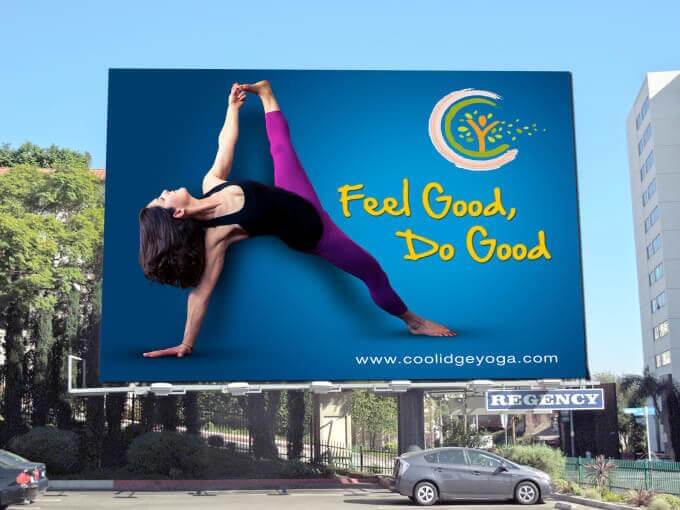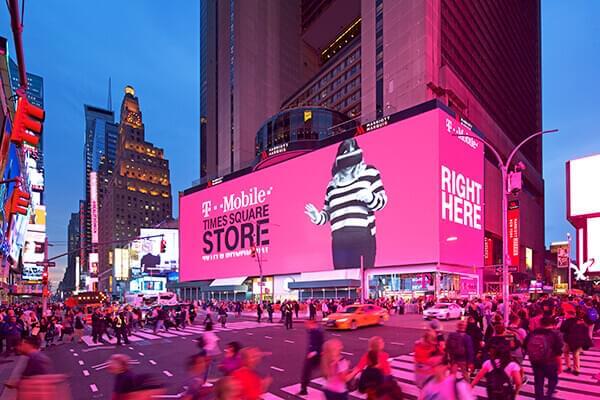
Billboards remain a valuable tool for brand promotion and growth, even in today’s digital age. The cost of having a billboard varies depending on several factors, making it essential to include in your marketing budget.
Even in today’s dominant digital era, billboard advertising remains highly effective. Whether we’re stuck in traffic or on a long road trip, a witty, engaging, and memorable billboard message is a welcome sight and a powerful outdoor advertising tool for business owners.
According to a report by the Outdoor Advertising Association of America (OAAA), every dollar spent on Out of home advertising (OOH) returns an average of $5.97 in product sales. That calculates to an incredible ROI of 497%.
Let’s dive in to understand what costs are associated with having that perfect billboard and why it’s worth working into your marketing budget.
The larger the market, the higher the cost
Location is one of the major determining factors in the cost of having a billboard. Outdoor advertising in major metropolitan cities like Toronto and New York will have a higher cost compared to small rural cities with smaller markets.
For example, back in 2018, Netflix bought prime billboard space along Sunset Boulevard in West Hollywood, which is one of the most desirable areas in Los Angeles. Capturing a spot on the busy sunset strip that is seen daily by celebrities and high-profile visitors allowed Netflix to successfully reach its target audience. However, the cost to have a billboard ad along that strip is twice more than that on any other street in Hollywood. It can be as high as $200,000 or more per month, thus showing the impact location can have on the cost of outdoor advertising.
In addition to that, the location of the OOH unit within a given market should also be taken into consideration. What does that mean?
- Is the billboard clearly visible and not obstructed by anything?
- Can it grab people’s attention or are they too engrossed with driving or distracted by other activities?
- Does the vicinity have competitor ads or other visual distractions that prevent people from giving your billboard ad the exposure it deserves?
All these aspects of location play a role in the cost of billboard advertising.

Format and Size
The format and size of a billboard are also huge indicators when determining its final price. There are many standard billboard sizes that companies can choose from, such as small poster-like ad units to gigantic billboards that dominate the area.
Generally speaking, the larger the format, the pricier it will be to purchase and produce. In addition to that, digital billboards are usually more expensive than traditional static billboards.
Visibility of the Ad
Another factor is circulation. This refers to the estimated number of people who will potentially view your ad or the exposure your ad will receive. The numbers are provided by local transportation and law enforcement authorities. These numbers, however, are only an estimate as to how many views your billboard ad will get throughout the course of its duration. The circulation will drive the cost of your OOH ad based on high or low-traffic areas.
The visibility of the billboard ad is a critical factor in the final price. The closer it is positioned to the road, the higher the price. On the other hand, if it’s located further back from the road, it will usually be less expensive.

Impressions: How are they calculated?
Impressions are a combination of location, format, and circulation and the easiest way to justify the cost of having a billboard. Impressions are calculated based on the likely viewership of your OOH advertising unit. This includes reach which measures the number of potential customers who see the billboard ad and frequency which is the number of times that those customers will be exposed to your ad. The calculations can also be affected by the location and size of your OOH ad unit, as well as factors that can improve or hinder viewers from actually seeing your ad.
For example, people are more likely to absorb a message displayed on a billboard while stopped at a busy intersection, as compared to one where people drive by quickly on the highway.
If we dive deeper, impressions are measured via CPM (cost per mille), which is the cost-per-thousand impressions or simply the cost that you would pay for your billboard ad to be seen by every one thousand viewers.
For example, let’s say you’re considering an OOH ad for your company’s latest marketing campaign and would like to maximize your exposure and reach potential customers. You have been presented with the following estimated cost of the billboard ad and the total impressions it will earn. Here’s how CPM will be calculated:
| Projected ad cost: $8 CPM |
| Total impressions the |
| billboard will earn: $100,000 |
| Cost: $100,000/1,000] x $8 = $800 |
Target Audience
Billboard advertising is not just about displaying your message to as many people as possible, but displaying it to the right audience – your target audience. With the rise and increase of OOH analytics, advertisers now have the opportunity to ensure that their outdoor advertising campaign reaches the right demographics, which include gender, age, education level, income, and so on. The demographics of people residing near your billboard can impact the cost of your OOH ad.
For example, the cost of a billboard ad in a location that is dominated by wealthy baby boomers and millennials will be higher as compared to a neighborhood with a higher percentage of elderly individuals.
Design, Construction & Installation
Factoring in the costs of these three additional elements into your budget is crucial. These key elements can highly impact your marketing budget, thus it’s important to buy a billboard at a reasonable price so that these steps can be carefully executed.
The production costs of a billboard depend on format and construction and range from $300 to $500 for a standard vinyl board. Design is also a vital part of creating successful eye-catching billboards, and hiring an agency or design firm can cost from $150 to $1000. Make sure you choose a design firm with highly experienced professionals, as a well-designed billboard ad is the best way to maximize your outdoor advertising ROI.
Now that we’ve reviewed the factors that contribute to the cost of having a billboard, let’s explore some of the different types of billboards.

Static, Mobile, or Digital?
There are a few different types of billboards that you can choose from for your OOH advertising campaign. These mainly include static, mobile, and digital.
Static: These are the types of billboards that are usually seen along major highways and streets across the nation. This form of advertising is targeted towards those who are in their vehicles. They use the same content and copy for a longer period of time, thus limiting the number of marketing opportunities you would have. Static billboards consist of a printed image glued on a billboard to get your message across to your audience. The cost varies depending on the size and length of the campaign and can range from $250 to $10,000 per month according to the location.
Static billboards are made up of vinyl and this is due to the fact that it’s weather resistant and will prevent deterioration. The cost to produce a vinyl billboard is about 50 cents per square foot. Printing costs can range from $300 to $500 for a 14×48-foot vinyl billboard which requires almost 700 square feet of material.
Mobile: Mobile advertising is a unique and effective way of reaching a large audience while still targeting specific populations of people. Mobile billboards can be seen on different mobile vehicles including buses, trucks, or trailers. It is often referred to as a form of guerilla marketing and uses vinyl posters or electronic screens to broadcast its message along directed routes of traffic.
Mobile billboards can also be frequently seen at major events like a summer parade or a large sporting event, allowing you to reach thousands of people at the same time. Some of them are also equipped with retargeting technologies, thus maximizing value and exposure for your business.
This type of outdoor advertising is becoming increasingly popular and compared to traditional media, has the lowest cost per impression. For the cost of one full-page ad in a newspaper, you can have a mobile billboard ad for a month. Mobile rates are a fraction of the cost of TV or radio and substantially lower than a static billboard.
Digital: This is one of the most popular and beneficial forms of outdoor advertising. It displays hundreds of different advertisements at a time. The duration of a digital billboard ad is a standard 8 seconds before the message changes and is part of a 64-second loop. Despite the fact that you share the screen with many other companies, viewers may see your ad multiple times during peak hours, as well as the billboard can be seen from a much longer distance.
The cost of a digital billboard depends on the size of the display, location, and the number of people who are potentially going to view it. A digital billboard that is 2’x8’ will cost around $4,400, whereas a billboard that is 14’x48’ in size will cost around $154,000.
For example, a digital billboard at Yonge and Dundas Square in the heart of downtown Toronto will cost around $200,000 each year.

Which type of billboard is best for your business?
It all depends on your advertising needs and your marketing budget.
Digital billboards are a great option for short-term promotions. Advertisers no longer have to buy the billboard space for a set long-term duration and video ads are more creative and catchy.
Static billboards still remain the largest outdoor media assets. It is the only type of medium that offers businesses 24-hour exposure that cannot be turned off, discarded, or overlooked, thus making them popular for campaigns that are designed purely to create and sustain awareness.
Mobile billboards are beneficial if you want to reach a large audience. You can cover an entire city and reach people you would never have with other types of billboards.

So what are the main takeaways?
There are several factors that are associated with the cost of having a billboard. Understanding how each of these factors enters into the pricing equation will make you better informed when you invest in a successful outdoor advertising campaign.
There’s a tremendous amount of value that can be gained by investing in OOH advertising. However, if you’re still skeptical, test the waters by launching a smaller outdoor campaign in a less expensive market. This will give you a better understanding of where you should be focusing your marketing efforts before investing in larger, more expensive media markets.
Ready to take the leap? Contact us today to learn how Movia can help with your next outdoor advertising campaign.


